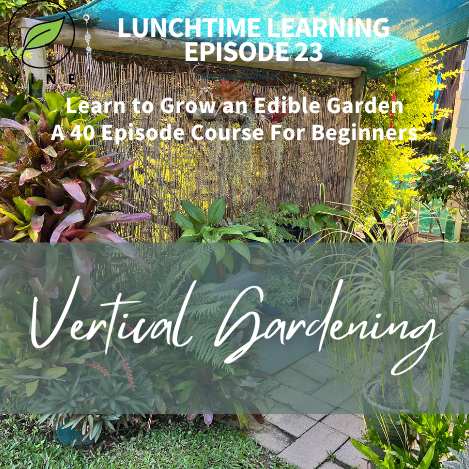Are you limited by space but still want to surround yourself with edible plants, or lush greenery and vibrant blooms? Look no further than vertical gardening! This innovative technique allows you to maximize your gardening potential by utilizing vertical spaces, whether it’s a small balcony, a courtyard, or even the walls of your home. In this blog, we will delve into the world of vertical gardening, exploring various methods and solutions that will help you to meet your garden goals.
Living Walls or Green Walls
Living walls, also known as green walls, are vertical gardens that adorn the sides of buildings or structures. These captivating installations not only provide aesthetic appeal but also offer numerous benefits. They help purify the air, reduce noise pollution, regulate temperature, and provide insulation. To create a living wall, you can use modular panels, pockets, or trays filled with a growing medium and appropriate plants. Some popular plants for living walls include ferns, succulents, ivy, and ornamental grasses.
Trellises and Espaliers
Trellises and espaliers are fantastic options for vertical gardening in smaller spaces. Trellises are frameworks made of wood, metal, or wire mesh that provide support for climbing plants. They can be attached to walls or freestanding structures. Espaliers, on the other hand, involve training fruit trees or ornamental plants to grow in a flat, two-dimensional manner against a wall or fence. This method not only saves space but also adds a unique architectural element to your garden.
Tower Gardens and Vertical Planters
Tower gardens and vertical planters are ideal for those with limited floor space. Tower gardens are vertical structures that enable you to grow plants in stacked layers. They typically use hydroponics, a soil-less growing method that involves nutrient-rich water and a growing medium such as rockwool or coconut coir. Vertical planters, on the other hand, come in various designs, including hanging pockets, stackable containers, and modular systems. These allow you to grow a variety of herbs, flowers, and vegetables while minimizing space requirements.
Hanging Baskets and Pots
Hanging baskets and pots are a classic yet effective solution for vertical gardening. They are versatile and can be hung from ceilings, walls, or sturdy hooks. Choose plants with trailing or cascading growth habits to create a stunning display. Popular choices include petunias, trailing geraniums, strawberries, and herbs like trailing rosemary or cascading thyme. Ensure that the baskets or pots have proper drainage to prevent waterlogging.
Pallet Gardens
Repurposing pallets as vertical gardens has gained popularity in recent years. By attaching plant containers or pockets to a pallet, you can transform it into a unique and functional growing space. Pallet gardens work well for growing herbs, small vegetables, or colorful annuals. Remember to line the back and sides of the pallet with landscaping fabric to prevent soil from falling through the gaps. Water regularly, as these are shallow planters and dry out quickly.
Whether you have a tiny balcony or a blank wall longing for life, don’t let limited space hinder your green thumb. Choosing to opt for living walls, trellises, tower gardens, hanging baskets, pallet gardens, pocket planters, or repurposed containers, you will maximize your growing potential. Remember to consider factors such as light availability, watering needs, and plant compatibility when designing. It can enhance the sustainability and productivity of your permaculture garden.
Integrating Vertical Gardening with Permaculture
Here are some ways in which vertical gardening can be integrated into permaculture:
Space Optimization
Permaculture principles focus on maximizing the efficient use of space. Vertical gardening allows you to make the most of limited space by utilizing
vertical structures. By growing plants vertically, you can increase the overall planting area and diversity within your permaculture system.
Companion Planting
Vertical gardening provides an opportunity to implement companion planting techniques within a confined space. By growing complementary plants together on trellises or planters, you can create mutually beneficial relationships. For instance, you can pair climbing beans with corn or grow cucumbers with sunflowers, promoting pollination, shade, and support.
Soil Health and Water Conservation
Vertical gardening methods such as tower gardens and hydroponics minimize soil usage or eliminate it altogether. In permaculture, this can contribute to better soil health by reducing erosion, nutrient runoff, and compaction. Additionally, vertical gardening systems often employ water-efficient techniques like drip irrigation or recirculating systems, promoting water conservation in your permaculture garden.
Microclimate Creation
Vertical gardening structures, such as living walls or trellises, can help create microclimates within your permaculture garden. These structures provide shade, wind protection, and temperature regulation, enabling you to grow a wider range of plant species. By strategically placing vertical elements, you can optimize sunlight exposure and control airflow, enhancing the overall resilience of your garden.
Biomass and Composting
Vertical gardening can contribute to your permaculture’s closed-loop system by providing an additional source of biomass for composting. As plants grow, they shed leaves, stems, and other organic matter that can be collected and recycled back into your garden’s compost pile. This cycle of organic material helps improve soil fertility and supports a sustainable nutrient cycle.
Biodiversity Enhancement:
Vertical gardening encourages biodiversity within your permaculture garden. By growing plants vertically, you can accommodate a greater variety of species, including pollinator-attracting flowers, herbs, and climbing vegetables. This diversity promotes ecological balance, attracting beneficial insects, birds, and other wildlife to your garden.
Aesthetic Appeal
In permaculture, aesthetics play a crucial role in creating a harmonious and inviting space. Vertical gardens add visual interest, texture, and beauty to your garden. They can transform plain walls into lush green backdrops or create captivating focal points. By integrating vertical gardening methods with permaculture principles, you can design an aesthetically pleasing and productive garden.
Remember, permaculture is about observing and working in harmony with nature’s patterns and processes. Vertical gardening provides a versatile and sustainable way to optimize space, conserve resources, enhance biodiversity, and create a thriving permaculture ecosystem. By embracing vertical gardening techniques within your permaculture practices, you can maximize the potential of your garden while minimizing your ecological footprint.



